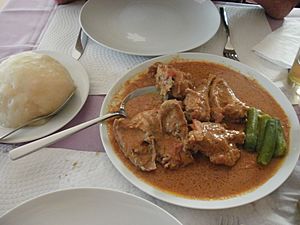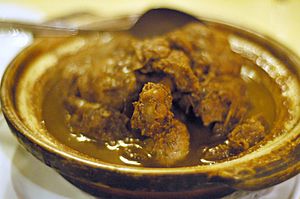Cabidela facts for kids
Cabidela (pronounced kah-bee-DEL-ah) is a traditional Portuguese dish. It is often called arroz de cabidela, which means "cabidela rice." This meal is usually made with poultry, most often a chicken. It comes from the northern Minho region of Portugal.
What makes Cabidela special is that the chicken's blood is added near the end of cooking. It is mixed with vinegar first to stop it from clotting. This mixture is added while the rice is boiling. The blood gives the dish a unique brown color. Sometimes, plain white rice is served with it, but this is not common. Cooking with blood is a very old tradition found in many cultures. In Portugal, Cabidela has been mentioned in writings since the 16th century. While chicken is most common, it can also be made with duck, turkey, pork, or other meats.
Contents
Where is Cabidela Popular?
Cabidela is not just found in Portugal. It is also popular in many places that used to be Portuguese colonies.
Cabidela in Macau
In Macau, a similar dish is very famous. It is called pato de cabidela or pato à cabidela. This version is made with duck instead of chicken. It is one of the most well-known dishes in Macanese cuisine.
Cabidela in Brazil
In Brazil, this dish is usually made with chicken. It is known as galinha à cabidela or galinha de cabidela. People consider it a typical dish of the city of Recife. It is also very common in the state of Minas Gerais. There, it is called galinha ao molho pardo, which means "chicken in brown sauce." In Brazil, the rice is often cooked separately from the chicken. Sometimes, only the chicken's blood, vinegar, and vegetables are cooked together. This makes a sauce that can be added to rice or the cooked chicken.
Cabidela in India
In India, a pork version of Cabidela is popular. You can find it among the Goan Catholic community in Goa.
Cabidela in Angola
The chicken version of Cabidela is very common in Angola. It is often served on special occasions. You can also find it in many restaurants there.
See also
 In Spanish: Cabidela para niños
In Spanish: Cabidela para niños



